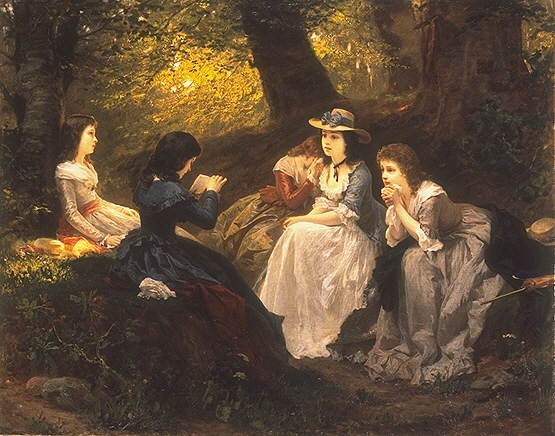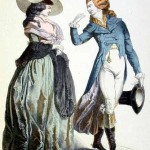
Wilhelm Amberg, “Reading Goethe’s Werther”
These past couple of weeks my Theories of the Reader class has been giving presentations upon “a literary work that became an event.” Rather unexpectedly, we found a single theme running through all the reports: works that have liberated young people have often been decried and sometimes even censored by their elders. This was true of Picture of Dorian Gray (see last week’s post), Catcher in the Rye, Lolita, Harry Potter (attacked by certain rightwing evangelical groups), Perks of Being a Wall Flower, and Are You There God? It’s Me Margaret. It was also true in 1774 of Goethe’s The Sorrows of Young Werther.
Natalie Rauscher, a German exchange student, reported on what was known as “Werther-Fieber” or Werther-fever. Goethe’s novel is about a young man who falls in love with a woman, Lotte, who is about to be married. They separate, he returns, they almost kiss but realize that they can never be together, and then he commits suicide. The book attracted younger readers because, as Nathalie explained, the young hero “stays true to himself and his feelings . . . He is the embodiment of the melancholic anti-hero of the time struggling with his identity and his life. He is empowered by his emotions at the end, … leaving the despised bourgeois life behind that trips him with his archaic moral and ethical ideas.”
 As she researched the book’s reception, Nathalie discovered that an entire cult grew up around it. (Note the rapt listeners in the painting above.) When the book sold out, young people copied it illegally and sold their own editions. They also wore blue jackets and dresses modeled on what the hero and heroine were wearing. Illustrated cups, saucers, plates and fans were produced, as were woodcuts and pictures. Natalie noted that one enterprising soul even produced an “Eau de Werther.”
As she researched the book’s reception, Nathalie discovered that an entire cult grew up around it. (Note the rapt listeners in the painting above.) When the book sold out, young people copied it illegally and sold their own editions. They also wore blue jackets and dresses modeled on what the hero and heroine were wearing. Illustrated cups, saucers, plates and fans were produced, as were woodcuts and pictures. Natalie noted that one enterprising soul even produced an “Eau de Werther.”
Natalie cited one letter where a reader wrote,
Here I sit with my heavy heart, with my pounding breast, and with my eyes dripping with sweet pain, and I tell you, reader, that I have just—read?—no, devoured The Sorrows of Young Werther, by our dear Goethe. Criticize it? If I could, I have no heart. . . . The reflections . . . included in the book are full of sense, knowledge of the world, wisdom and truth.
As Natalie noted, young people of the age “wanted to feel something, even if it was painful.” They wanted their lives to be filled with meaning.
Authorities hated the book with the same intensity that young readers loved it. Sermons were preached against it and editorials denounced it. Nathalie said that, in addition to emphasizing emotions during an age when the focus was on calm and tempered Reason (Werther helped initiate Germany’s sturm und drang or “storm and stress” period), the book also appeared at a time when literacy was expanding rapidly and when (with the upcoming revolutions) life and society were about to change dramatically. Thus the older generation saw the book as encouraging young people to rebel against authority and begin thinking for themselves. If young people began to be guided by their emotions, then carefully arranged marriages were in jeopardy, as was class structure itself.
Today, of course, the novel is just seen as a dry classic that young Germans are required to read in high school. At one point in history, however, it shook the world.
2 Trackbacks
[…] that a work aroused or continues to arouse. Examples include 18th century German parents attacking Goethe’s Sorrows of Young Werther, 19th century audience members rioting during the premiere […]
[…] that a work aroused or continues to arouse. Examples include 18th century German parents attacking Goethe’s Sorrows of Young Werther, 19th century audience members rioting during the premiere […]